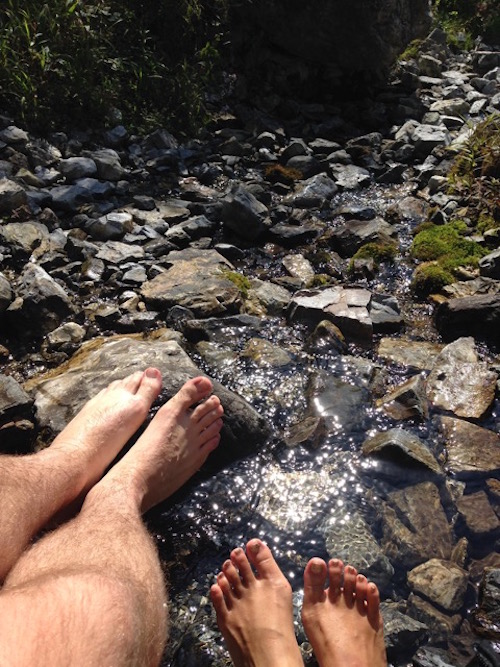
To squeeze in more camping trip before the weather turns, my boyfriend and I headed to Xiangshuihu National Park (响水湖自然风景区) this past weekend to hike the wild Great Wall. I’d been to more remote sections of the Wall before – Jiankou, Gubeikou, and Huanghuacheng – but Xiangshuihu was the least restored yet, with crumbling ramparts and wild flowers dotting the ascent. Here’s how to reach it.
We found out about the park through a Google search, then booked a driver to take us there on Saturday morning and pick us up on Sunday afternoon.
Admission cost RMB 32 per person plus a camping fee of RMB 50 for every two-person tent. On the phone, a park employee told us there was a designated camping "area" – which, to our deep bemusement, turned out to be an empty parking lot. We said "xie xie but no xie xie" and slipped away to find a more secluded spot in the woods.

Xiangshui Lake is a misnomer; the "lake" is actually a natural spring that originates 550m above sea level and feeds into the Huairou Reservoir.

The source of the spring is inaccessible and covered with concrete, but a path to the right of Xiangshui Villa – the main hotel just past the parking lot – leads to a series of waterfalls and terraced gardens. At the top of the path is a modest temple with a pond and a receptacle to throw coins in.

Climbing the Great Wall
The entrance to Xiangshuihu Great Wall is across a metal bridge about 200m past Zhuanghu Village (庄户村). You’ll recognize it by the giant sign that says, quite ironically, "This part of the Great Wall is inaccessible to visitors."
We set up camp in the small orchard to the left of the trail. Seeing bundles of firewood lying around, I kept expecting a farmer to emerge and chase us off his property, but no one bothered us.
The hike starts in earnest at the trail leading off from the metal bridge. We had to watch out for jutting roots and loose rocks, but otherwise the first part of the ascent was pretty straightforward.

At first, we couldn’t even tell we were on the Great Wall; the Xiangshuihu section is so overgrown that the walkway in some parts is barely visible among the wildflowers, brambles, and bushes.
This section is connected to Liangyuling in the west and Moshikou in the east. Mutianyu is only 15 minutes away by car, making this a great alternative for those who’d rather avoid the crowds and see an unrestored part of the Great Wall.

We barely encountered any other hikers over the next two hours. We stopped periodically to take in the sweeping views or eat trail mix atop one of the guard towers. Lizards, small and ubiquitous, slithered across our paths and into cracks in the Wall.

The gnarliest part of the hike came near the halfway point, when we encountered a nearly vertical rock face with crumbling steps and treacherous sliding pebbles. We gripped whatever we could and ascended very carefully.

After a slow climb, we emerged victorious at the Beijing Knot (北京结), a junction where three parts of the Great Wall come together.
At 1,239m elevation, the Beijing Knot afforded 360-degree views of the surrounding mountains, villages, and other sections of Great Wall. From the guard tower, we also spotted the famous umbrella-shaped pine tree.
We then retraced our steps and headed back down for dinner. Climbing down the steep section of Wall was even more harrowing than the climb; I slid a couple of times over the loose rocks but we managed to get down OK. In total, the hike took about 3.5 hours.

That night, we ate at one of the many nongjiayuan (farmers’ houses) offering food and places to stay in Zhuanghu Village. Service was very friendly and laid-back. Apart from us, there were two large tables of customers who offered just the right amount of bustle for the cool night.



We had deliciously crispy jiachang bing (home-style pancakes), stir-fried chives and river shrimp (RMB 36), grilled fish (RMB 28 per jin plus RMB 20 "processing fee"), and country-style tofu (RMB 18).
The owner also recommended a clear fish soup made by boiling the head and bones of the fish in our main dish (RMB 18). It turned out to be a good call; the piping hot broth was comforting and deeply warming.
After dinner, we strolled back to our campsite, heavy with food, and were floored by the resplendent full moon; I’d completely forgotten it was Mid-Autumn Festival. With nothing but the sound of crickets around us, it was the perfect way to spend the holiday.

The Koi Farm
The next day, we explored an easy-to-miss trail between Zhuanghu Village and Xiangshui Villa, that led – much to our surprise – to a koi farm with multiple pools. The trail head starts down to the right of a blue sign extolling the virtues of Xiangshui Lake in Chinese and Chinglish.

As we approached the koi farm, the friendly owner came out to greet us. He allowed us to set our packs down at his house while we checked out the nearby springs.

The water level was low this year due to a lack of precipitation, but we were able to dip our feet into the gargling streams. The temperature was very brisk – between 8 and 10 degrees Celsius year-round – but the water felt refreshing on my skin after a hard day of hiking.
Hiking difficulty: Medium to hard. Parts of Xiangshuihu Great Wall are very steep and slippery, and require scrabbling over rocks to get to the top. This hike wouldn’t be suitable for families with young children or people with mobility issues. Depending on your level of fitness, the hike from Zhuanghu Village to the Beijing Knot takes about 4-5 hours roundtrip. If you’d rather go with an experienced guide, Beijing Hikers runs excursions to the Beijing Knot.
Staying at Xiangshui Lake National Park: There are two parking lots: one at the entrance to the park and one past the gate. There’s only one park entrance and one main road within the park.
If you book a driver (which I’d recommend), ask them to take you past the gate or you’ll need to take a long walk up. If you’re being dropped off for camping, tell the guard and he’ll let the driver in without making them pay admission.
If it’s too cold to camp, you can stay at Xiangshui Villa or one of the many farmers’ houses in Zhuanghu Village.
Family-friendly facilities: The path next to Xiangshui Villa is suitable for younger children but isn’t stroller-accessible. There are clean public toilets all over the park, including the main parking lot, on the path before the koi pond, and in Zhuanghu Village. There are lots of country-style restaurants within the park, some street vendors selling seasonal products like honey and pears, and a couple of xiao mai bu for water and other essentials.
In a nutshell: This is an excellent destination for avoiding the crowds, but be prepared for some hard hiking. Xiangshuihu Great Wall is beautiful and wild, but also very dangerous in some parts; it is not suitable for young children, the elderly, or those with mobility issues. Bring good hiking shoes, a hat, sunglasses, sunscreen, mosquito repellent, sufficient hydration, and trail snacks.
Sijia Chen is a contributing editor at beijingkids and a freelance writer specializing in parenting, education, travel, environment, and culture. Her work has appeared in The Independent, Midnight Poutine, Rover Arts, and more. Follow her on Twitter at @sijiawrites or email her at sijiachen@beijing-kids.com.
Photos: Sijia Chen and Dillon Powers



